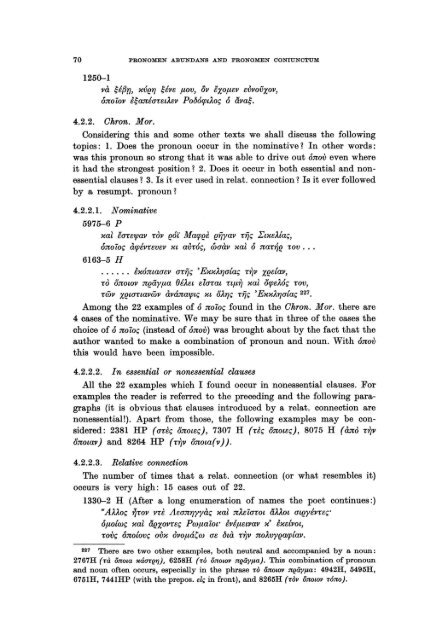Pronomen Abundans and Pronomen Coniunctum. A ... - DWC
Pronomen Abundans and Pronomen Coniunctum. A ... - DWC
Pronomen Abundans and Pronomen Coniunctum. A ... - DWC
You also want an ePaper? Increase the reach of your titles
YUMPU automatically turns print PDFs into web optimized ePapers that Google loves.
70 PRONOMEN ABUNDANS AND PRONOMEN CONIUNCTUM<br />
1250-1<br />
lIà UfJn, "Ve1j Uve p,ov, 8v ëxop,ev evvovxov,<br />
ónoiov è;wrÉcn:uAev Po~óqJtAOÇ ó äva;.<br />
4.2.2. Ohron. Mor.<br />
Considering this <strong>and</strong> some other texts we shall discuss the following<br />
topics: 1. Does the pronoun occur in the nominative? In other words:<br />
was this pronoun so strong that it was able to drive out ónov even where<br />
it had the strongest position? 2. Does it occur in both essential <strong>and</strong> nonessential<br />
clauses? 3. Is it ever used in relat. connection ? Is it ever followed<br />
by a resumpt. pronoun?<br />
4.2.2.1. Nominative<br />
5975-6 P<br />
"al ËaTeljlav Tàv eóï Maq;eÈ eijyav Tijç Et"eAtaç,<br />
ónoioç àq;tvTevev "t aVTóç, waàv "al ó naT~e 'lov . ..<br />
6163-5 H<br />
è"ómaaev aTijç 'E""A1jataç T1]V xeetav,<br />
Tà önotQlI neäyp,a ()éAU elaTat np,1] "al oq;eA.óç TOV,<br />
TWV xetaTtaVWlI àvcbtaljltç "t ÖA.1jç TijÇ 'E""A1jataç 227.<br />
Among the 22 examples of ó noioç found in the Ohron. Mor. there are<br />
4 oases of the nominative. We may be sure that in three of the cases the<br />
choice of ó noioç (instead of ónov) was brought about by the faot that the<br />
author wanted to make a combination of pronoun <strong>and</strong> noun. With ónov<br />
this would have been impossible.<br />
4.2.2.2. In e8sential or nonessential clause8<br />
All the 22 examples which I found óccur in nonessential clauses. For<br />
examples the reader is referred to the preceding <strong>and</strong> the following paragraphs<br />
(it is obvious that clauses introduced by arelat. connection are<br />
nonessential!). Apart from those, the following examples may be considered:<br />
2381 HP (arèç önoteç), 7307 H (rèç önoteç), 8075 H (ànà TiJlI<br />
önotall) <strong>and</strong> 8264 HP (T1]V önota( 11 )).<br />
4.2.2.3. Relative connection<br />
The number of times that arelat. connection (or what resembles it)<br />
occurs is very high: 15 cases out of 22.<br />
1330-2 H (Af ter a long enumeration of names the poet continues:)<br />
"AAA.OÇ 1}TOll vrè Aean1jyyàç "al nA.ÛaTot äA.AOt ateytvreÇ"<br />
óp,otwç "al äexovreç Pwp,aiot· èvép,etvav ,,' è"etvot,<br />
ToVÇ ónotovç OU" ovop,áCw ae btà T1]lI noA.vyeaq;tav.<br />
-----<br />
227 There are two other examples, both neutral <strong>and</strong> accompanied by a noun:<br />
2767H (t'à l571ma ~á(]TeTJ), 6258H (Ta l5nowv neäyp.a). This combination of pronoun<br />
snd noun of ten occurs, especially in the phrase Ta l5nowv neäyp.a: 4942H, 5495H,<br />
6751H, 7441HP (with the prepos. elç in front), <strong>and</strong> 8265H (Tav l5nowv Tóno).
















